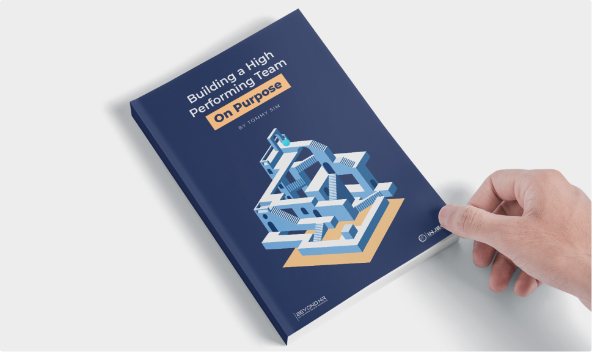This is part five of the eBook, Building a High Performing Team on Purpose.
Talent Management: Hire and promote candidates based on competencies that support delivering your business strategy
“Excellent” said Mr Burns, pushing the buttons on his imaginary flute with both hands. Seated at his desk he looked up towards Smithers, instructing his trusted assistant to go out and swoop up all the outstanding talent who had lost their jobs during the COVID-19 crisis. Smithers gave his typical groan when he knew his boss had given him an impossible task that he had to find a way to work. Wayland moved to protest to Monty, only to find himself directed to the doorway with a loud “NOW!”
Besides the fact that no one actually wants to work for Mr. Burns, the groan of Smithers is due to the insight that there is not actually the treasure trove of talent that is assumed to be out there. What he can count on is the sea of resumes that will crash through his inbox, requiring a lot of work to sift through. It’s not going to be that easy to find great talent. They will probably end up re-hiring Homer.
The resume of a poor performer sometimes looks very similar to that of a high performer
Have you ever heard this saying?
“Nobody got fired for buying IBM!”
This phrase became famous several decades ago and represents the “safe bet” of choosing computers, much like why no large corporation chooses anyone but a Big Four accounting firm to conduct their audit. If you choose the safe bet and it doesn’t work out, well you are not to blame and were just plain unlucky, weren’t you?
If you’re a business owner or leader in charge of your own fate, you don’t need to live by this mantra. There is no butt-covering required and so you are in the box seat to avoid following what everyone else is doing. I have a feeling you knew this already. So then why does this candidate profile often ring true?
- Industry experience – “our industry is very different and so you need to know who is who and the terminology”.
- Systems knowledge – “our system can be difficult to navigate and our training is not up to scratch yet”
- Good references – “Their past employers thought they were good”
In Chapter 3: Your Organisational Design, I mentioned that managers often focus on “crystallised intelligence” (what a person knows right now, such as the capital of Switzerland), rather than “fluid intelligence” (the ability to seek out and absorb new knowledge) when defining what they are looking for. This is often due to managers being time poor, or in my language I view that as being energy poor. They just want someone to come in ready made to “hit the ground running.”
Sometimes, it is necessary to prioritise crystallised intelligence if there is none that exists in the company or to balance up an inexperienced team. Also, you sometimes need some crystallised knowledge as a ticket to play regardless of how talented someone is. It’s just that the requirement is too often overstated and it is not a source of competitive advantage to do so continually as it only catches you up in the short term. If this is your approach it may mean that you are not organised with your workforce planning and/or your staff turnover is too high.
Constantly chasing your tail is not how you hire for a high performing team on purpose.
But wait… if a finance person has no idea about Microsoft Excel, that rings alarm bells for me! In some cases, systems knowledge is more important as an indicator, rather than the specific skill itself (albeit the skills also being useful). Using this example of Microsoft Excel, if in a finance position, all a candidate knows how to do is SUM, then this is possibly an indication they haven’t really explored its power.
They don’t need to know how to do a combination IF(AND(OR… statement specifically, you just need to be someone curious and smart enough to figure it out. It’s a possible indicator of analytical thinking and learning curiosity. You want to know their natural energy goes towards the important parts of the role. Hiring for a system specifically (often people think of their ERP) will severely limit the talent pool you can choose from and the most capable people will surpass most others in 6 months anyway.
Another common mistake is to overly prioritise existing industry and product knowledge. This might help in the short term because the manager doesn’t need to put in much effort to train them. But this crystallised knowledge is less valuable than learning agility and influencing ability. There will be many people who have bounced around the industry as sales people and know a lot of terms and technical jargon, but lack the ability to have a proper conversation with a business owner or to learn new products that are required to remain competitive in the market. The manager may also assume that the industry person knows a bunch of things that they actually don’t, until they find out two years later when the sales results are not there.
Nearly every industry has a challenger brand or one that is looking to deliver a premium product or service to the market. If this doesn’t exist, there is probably a replacement industry on its way to disrupt the entire market. Businesses that are looking to build and maintain a competitive advantage, but are stuck in these old ways of looking at prospective employees are missing a golden opportunity. To amplify how much this is going to become even more important, in a recent World Economic Forum study, they predicted that 54% of employees will require re-skilling and re-training by 2022.
So why are people still hiring on criteria that does not correlate with high performance? The most common reasons are:
- Having a short-term view and wanting to just fill a gap
- A lack of interest in spending time on training and development
- Missing knowledge on what actually drives performance (even if intuitively it is known)
- Never having experienced what it is like to hire a true high performer on purpose
- Because everybody else uses the same criteria
I find that small-medium business owners and leaders are best placed to come to the realisation that hiring based on the resume and references is fraught with danger. It usually takes a few poor performers for the realisation to set in that there must be a better way. They are the ones that experience immense pain, due to negative impact on performance, the toxicity of culture and the increased workload and stress for that leader.
Exercise
Let’s look at a position in your company that you might want to hire for in the future. I will use an example of a Sales Manager for illustrative purposes (the list won’t be exhaustive). Write down a list of what you would see from a high performer versus a low performer.
- List the things that a high performer does
- Develops, clarifies and gains buy in for the sales strategy across the executive team
- Hires sales people based off talent for sales, their attitude and aptitude
- Work with those not suited to sales or the company to move to a different job
- Invests in their own personal learning and development, particularly leadership and management
- Spends time out on the road with the sales team, providing feedback and coaching
- Makes the right judgement call as to when to step in and when to let a sales person make their own mistakes
- Work collaboratively with operations and other important internal stakeholders to align their priorities
- What would a poor performer be doing?
- Spend too much time selling directly themselves
- Justify to the executive team that the reason targets are not hit are due to poor sales staff
- Complain about operations, finance, pricing, the market, customers
- Avoid having difficult conversations with people until it gets to breaking point and then create an environment of fear through constant ultimatums
- Spend little time coaching and developing their staff
- Solve problems for customers and then throw their team under the bus
- Say yes to everyone, including the sales team, customers, suppliers, internal stakeholders
Whether you agree with this list or not isn’t the main point here and each situation will of course be different and so the specific context would change the priorities. Most would agree that the first list is significantly better than the second list. But what do you notice? These are all behaviours that you can observe. Each list of high performers or low performers could apply to someone from the industry, or outside of the industry.
Hiring for talent and mindset means leveraging the natural energy of people
It’s better to leverage the natural energy of the person than to fight against it. Issues are presented if you are constantly using your own energy to try and push this person in the direction you want. When you give an employee your energy, whether that be effort to help them learn, providing them insight into priorities or to set up the right relationships – you want them to take this and build on it. You don’t want your energy to just be lost. This is why so many business owners and leaders are exhausted by their people. They are expending so much energy on their people and getting very little in return.
If I were to say to hire based on things like talent, attitude and learning agility, well that would make sense right? Most people would be nodding their heads to that and then say “Yeah, but right now we just need experience. We don’t have the luxury to do that at the moment.” Besides the cost of getting it wrong, one bad experienced hire will set you back 6-12 months or even longer. All the while the person who has the right mindset, who furthers the right positive culture in your company and whose natural behaviours perfectly suit the role could have been learning your business.
The issue with poor performers is that it is never the issue that a manager says that they have an issue with this person due to their current lack of knowledge. Assuming the issue is not due to the manager’s inability to lead and develop this person, the issue with the employee’s performance is nearly always due to one of the following:
- The work they are meant to be focusing on is not what they are focusing on. They seem to find time for tasks that are less important and will justify why they don’t have time for the most valuable activities from the manager or business’s perspective
- Their attitude towards work is about what they can take from the company, not what they can give
- Their attitude towards other people rubs them up the wrong way or they are toxic for the culture
- They are not learning things fast enough, having the repeatedly ask the same question and then still get it wrong
Some of you might be thinking, “So, you want me to hire young and inexperienced people all the time?” No, that’s not the message. It’s about the fact that people prioritise the wrong things and so there is a need to push one message to balance the ledger.
However, to answer this concern more specifically, let’s break down experience for a moment. The problem with experience (and in particular years of experience) is that it is not specific enough. One year in Company A working for Manager A may be significantly more valuable than five years in Company B working for Manager B. Even within Company A and Manager A, Employee 1 took every opportunity to learn and apply what they learnt, whilst Employee 2 sat back and didn’t take in anything. If Manager A was a great teacher and coach, but not great at moving on poor performers then both Employee 1 and Employee 2 could have similar looking resumes.
It’s important to know that hiring for talent doesn’t simply mean hiring young people, as sometimes people mistakenly think. The assumption that a young person will be keen and open to learning is not always true. The strategy to hire for talent works just as well when looking at a fifty-year-old who may bring transferable skills and abilities with a greater thirst for learning than some twenty-year-olds. The message is that it is about the person, not the piece of paper of where they have been.
Be enlightened enough to know that you are not a genius people-reader
“I’m a great judge of character.” Said no one who understands confirmation bias.
Some of you may have read an article I wrote a while back on confirmation bias. In particular, the example of the guy in the red jumper stood out for a lot of people. The story goes like this…you are arriving at a party and your friend is leaving. You ask how the party is that they say, “Great! Except avoid the guy in the red jumper.” You enter the party and then later on notice the guy in the red jumper. He looks like a creep and you avoid him.
Now change that around and when your friend leaves, they say to you “Great! Make sure you speak with the guy in the red shirt, he’s eccentric but such an interesting and lovely person.” When you see him at the party you are instantly drawn to talk to him. Same guy, different outcome.
As human beings we hate uncertainty. The unsettling feeling this gives compels us to find an answer that we can tell ourselves is the right one. During a hiring process, this is constantly happening with hiring managers. The first look at the resume. The first meeting with that person. Whether you feel positively or negatively about that person you will start to look for reasons why they are right or why they are wrong.
Confirmation bias is just one of many biases that exist during a hiring process. When people present a certain way that reminds us of ourselves or someone else we like, we instantly feel good about that person and are more likely to hire them. Just remember, knowing all of your mates, not all of them would be the best employee, or if they would be, they would certainly not be right for every role you might have.
Conformity bias is when there are multiple people in a selection process and the majority of people or perhaps the most powerful person gives a view on a candidate. Once that view is out there, everyone else falls into line and ignores the observations they had that contradict that person’s view.
There is one last bias I will mention which is comparison bias, which results in hiring the best from a bad bunch or missing out on that right person. That is, human beings love the number three for some reason. Three blind mice, Neapolitan Chocolate and Gold, Silver Bronze. There seems to be a rule of three that exists in hiring that is we need three candidates to compare and to pick the best from that shortlist. What if all three are wrong? What if you only see one person and they are right and you lose them to another company because you were waiting for another two to compare them to.
I could go on as there are at least ten different types of biases that are swaying you towards hiring a poor performer. Step one is to be aware of them and admit you are not immune. This will lead you to…
Use a robust selection process and multiple objective assessments
“Our hiring process has worked for us before. It’s just that you can never really know.”
Well, even a broken clock is right twice a day.
The assessments that exist today that will help you make a more accurate decision to hire have been around for a long time. However, the uptake of using those assessments is still relatively low when compared to how many people are hired, particularly in small-medium businesses.
To make things clear, I need to tell you that I have interviewed thousands of people. I have reviewed the personality profiles and aptitude results in-depth of at least several hundreds of people, if not in the thousands. These assessments are from a world leading psychometric assessment company, which yes – it does make a difference. Most importantly, I have been a part of discussions with managers after the person has been hired to review what actually happened.
I could talk to you about studies that have looked at predictive validity and the strength of aptitude testing, structured behavioural interviews and personality profiles. Most people I speak with find that direct personal experience is more valuable. So I will tell you that across the past 20 years that I have a lot of direct data from all the different situations I have seen. The many success stories of situations where the assessments predicted a high performer have been great. However, it is perhaps when people have chosen to go against the assessments and instead favour criteria that relates to biases, resumes or simply recruitment fatigue (choosing someone because they want to stop having the recruit) that even more value has been achieved. If I didn’t have people going against the recommendation from time-to-time, then I couldn’t have contrasting data to review.
So it’s important to use a holistic approach with valid assessments to uncover a more comprehensive view of a person you are potentially bringing onto your payroll. This is best illustrated by the Venn Diagram below:
Yes, it’s more work and yes, it costs more money. But if you aren’t convinced that it is worth the effort to hire the right person then you may need more trial and error experiences until you get there. Seeing what I have seen, I want as many people to stop going through the process of learning from their own mistakes. The challenge for me to try to get across the message to people that they aren’t a mind reader and that just because they want this candidate to be the right one, it doesn’t make it so.
We are fighting against human nature here. What is encouraging though, is that with each business leader we work with who is open to learning new things, who values the right people and has the discipline to apply the right process, that we are slowly seeing a change towards hiring the right people consistently. This is the most important point around this whole series and for every chapter: When people tell you that you are really lucky to have a high performing team, I want you to think to yourself and to tell them that it was not luck, it was on purpose.
Key take-aways:
- Challenging the industry with a differentiated strategy requires a different type of workforce, so with a deliberate talent strategy to hire, retain and develop talent that competition is not fishing for can create an inimitable competitive advantage
- Hiring people more on talent and mindset than on their existing technical knowledge gives you a better chance of building a high performing team
- In today’s context, knowledge is evolving and roles are changing, so the ability and willingness for employees to learn will be key
Recommended actions:
- Following the review of your strategy and your organisational and job design, you will have the criteria in which to hire against
- Complete forward-looking workforce planning activities to plan out how you will hire for the business ahead of simply replacing exits
- Hire based off the strategically required competencies, talent, attitude and aptitude
- Use valid and robust assessments in combination to identify a clear and accurate view of candidates
You can read Chapter 4: Your Leadership here.




